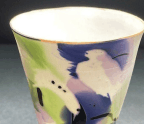Vasudhaiva Kutumbakam at Roopankar Museum of Fine Arts

atterning ignited civilization. Imposing pattern is so fundamental it is essential to be not just human beings. Birds migrate. Bears hibernate. My dog walks in a spiral before lying down. Because, simply − for over 99% of our history, humans have been too busy chasing calories to do much civilization-building. Recognizing when beasts were going to be and when and what seeds can be planted and eaten allowed humans to stop running and start creating. On a basic level, civilizing has been an increasingly complex and intricate imposition of pattern on the chaos of the world. Planting seeds when the sun is at a certain point and using fractals to design a better microchip are the same intellectual endeavor. Existence is more than just layers of increasingly intricate patterns. It is filled with randomalities like floods, droughts, (Sanskrit: the whole world is one family) an exhibition of 15 invited international artists, 26 juried Indian artists, and three eminent traditional terracotta artists at Roopankar, The Museum of Fine Arts, Bharat Bhavan art complex in Bhopal, India. The importance and limitations of asserting pattern onto human experience resonate throughout the exhibition.
You’re reading a preview, subscribe to read more.
Start your free 30 days



